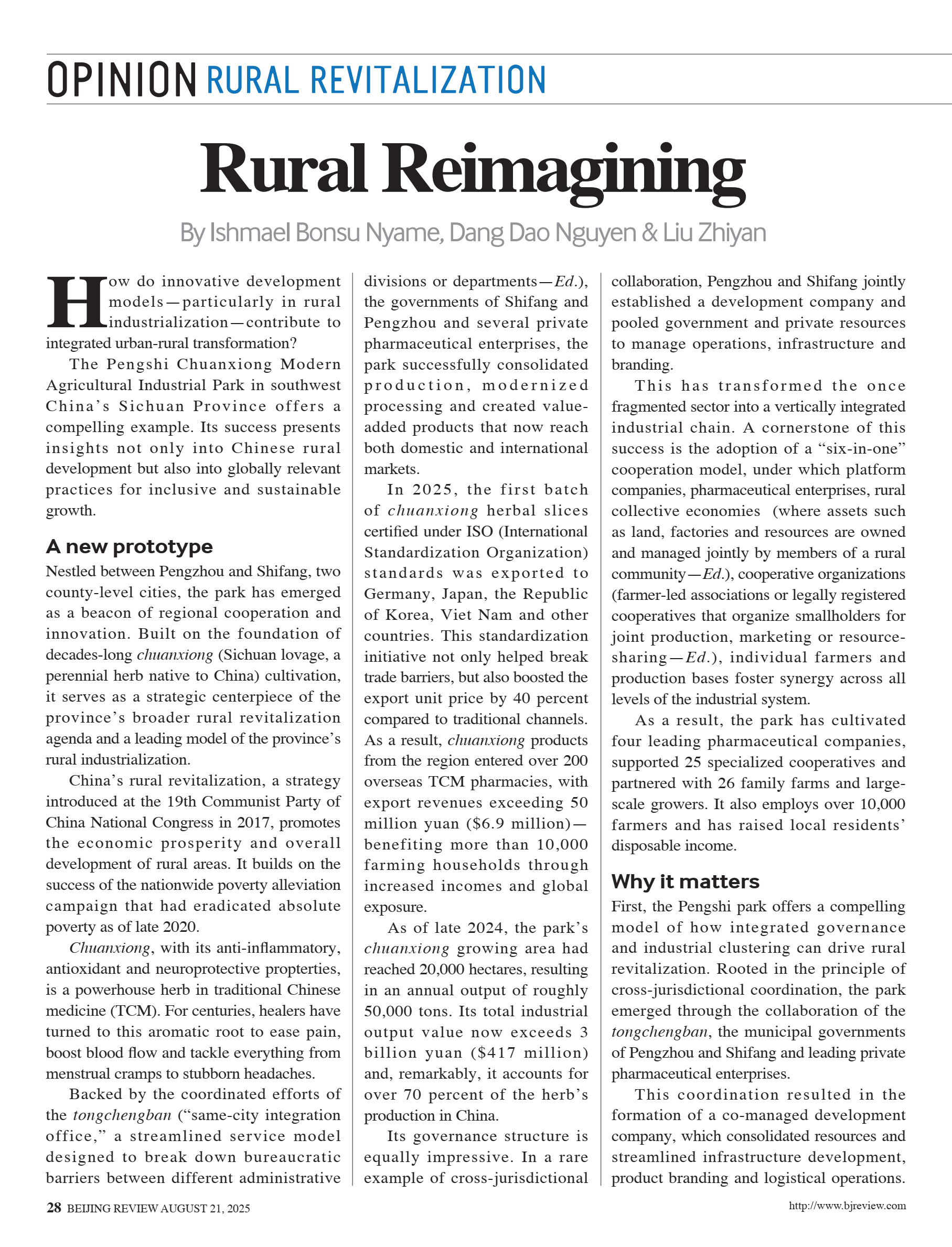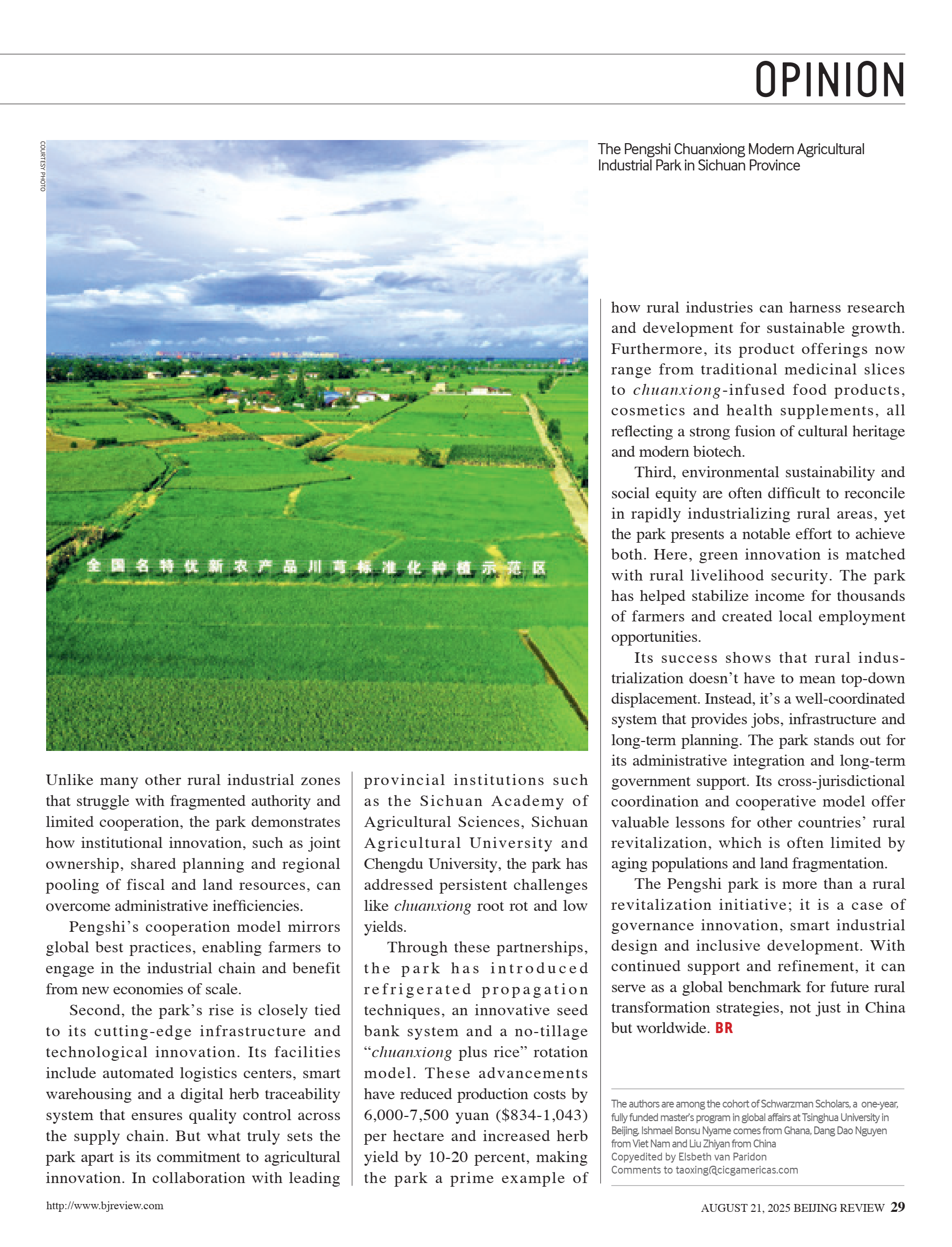2025年5月,由清华大学中国新型城镇化研究院参与指导的清华大学苏世民书院Capstone人才培养课题《四川成都的农村经济发展:一个四阶段城乡融合发展框架的视角分析》(The Development of Rural Industries in Sichuan, China within the Framework of Integrated Urban-Rural Development)顺利完成硕士论文答辩。近日,课题组的国际学子们在《北京周报》(BEIJING REVIEW) 撰文,围绕典型案例——四川省彭什川芎现代农业产业园,多元视角讲述构建城乡融合发展新格局的“中国故事”。
【作者】
Ishmael Bonsu Nyame comes from Ghana
Dang Dao Nguyen from Viet Nam
Liu Zhiyan from China
【来源】
《北京周报》(BEIJING REVIEW) 2025年第34期



城乡融合发展是中国式现代化的必然要求。党的十八大以来,我国在统筹城乡发展、促进城乡共同繁荣方面取得了显著进展,全国各地因地制宜积极探索推动大中小城市和小城镇协调发展。
为引领国际青年学子深入探讨这一进程中涌现出的中国特色新模式、新路径,清华大学中国新型城镇化研究院于2024年受邀参与清华大学苏世民书院Capstone人才培养项目,带领3名国际学子以“城乡融合”为主题展开深入研究。
苏世民书院秉承“立足中国、面向世界”的原则,致力于培养深入了解中国与世界的未来全球领袖。此次课题吸引到3位书院国际学子——来自加纳的Ishmael Bonsu Nyame,来自越南的Dang Dao Nguyen,以及来自中国的刘芷岩(Liu Zhiyan),并由书院常务副院长潘庆中教授担任硕士论文学术指导老师,研究院科技部主任王强、研究专员谢力唯担任行业专家指导。同学们在半年多时间里,详细了解和深入解析了中外多个国家在城乡融合发展方面的不同路径选择和发展趋势,并通过典型案例解码中国城乡共生的内涵式高质量发展之鉴。
作为同学们选取的区域合作与创新标杆样本,彭什川芎现代农业产业园是在四川省推进成德眉资同城化发展领导小组办公室统筹下,由彭州、什邡两地政府联合多家民营药企,成功构建的集生产、精深加工、高附加值产品开发于一体的全产业链园区。目前该园区川芎种植面积达2万公顷,年产量约5万吨,工业总产值突破30亿元,产品远销海内外,带动万余农户增收并走向国际。同学们表示,该园区为“协同治理+产业集群”驱动城乡融合提供了范本,也为全球包容性可持续发展贡献了具有普适参考价值的实践方案。

课题组成员硕士学位论文答辩现场
Rural reimagining
How do innovative development models—particularly in rural industrialization—contribute to integrated urban-rural transformation?
The Pengshi Chuanxiong Modern Agricultural Industrial Park in southwest China's Sichuan Province offers a compelling example. Its success presents insights not only into Chinese rural development but also into globally relevant practices for inclusive and sustainable growth.
01 A new prototype
Nestled between Pengzhou and Shifang, two county-level cities, the park has emerged as a beacon of regional cooperation and innovation. Built on the foundation of decades-long chuanxiong (Sichuan lovage, a perennial herb native to China) cultivation, it serves as a strategic centerpiece of the province's broader rural revitalization agenda and a leading model of the province's rural industrialization.
China's rural revitalization, a strategy introduced at the 19th Communist Party of China National Congress in 2017, promotes the economic prosperity and overall development of rural areas. It builds on the success of the nationwide poverty alleviation campaign that had eradicated absolute poverty as of late 2020.
Chuanxiong, with its anti-inflammatory, antioxidant and neuroprotective propterties, is a powerhouse herb in traditional Chinese medicine (TCM). For centuries, healers have turned to this aromatic root to ease pain, boost blood flow and tackle everything from menstrual cramps to stubborn headaches.
Backed by the coordinated efforts of the tongchengban ("same-city integration office," a streamlined service model designed to break down bureaucratic barriers between different administrative divisions or departments—Ed.), the governments of Shifang and Pengzhou and several private pharmaceutical enterprises, the park successfully consolidated production, modernized processing and created value-added products that now reach both domestic and international markets.
In 2025, the first batch of chuanxiong herbal slices certified under ISO (International Standardization Organization) standards was exported to Germany, Japan, the Republic of Korea, Viet Nam and other countries. This standardization initiative not only helped break trade barriers, but also boosted the export unit price by 40 percent compared to traditional channels. As a result, chuanxiong products from the region entered over 200 overseas TCM pharmacies, with export revenues exceeding 50 million yuan ($6.9 million)—benefiting more than 10,000 farming households through increased incomes and global exposure.
As of late 2024, the park's chuanxiong growing area had reached 20,000 hectares, resulting in an annual output of roughly 50,000 tons. Its total industrial output value now exceeds 3 billion yuan ($417 million) and, remarkably, it accounts for over 70 percent of the herb's production in China.
Its governance structure is equally impressive. In a rare example of cross-jurisdictional collaboration, Pengzhou and Shifang jointly established a development company and pooled government and private resources to manage operations, infrastructure and branding.
This has transformed the once fragmented sector into a vertically integrated industrial chain. A cornerstone of this success is the adoption of a "six-in-one" cooperation model, under which platform companies, pharmaceutical enterprises, rural collective economies (where assets such as land, factories and resources are owned and managed jointly by members of a rural community—Ed.), cooperative organizations (farmer-led associations or legally registered cooperatives that organize smallholders for joint production, marketing or resource-sharing—Ed.), individual farmers and production bases foster synergy across all levels of the industrial system.
As a result, the park has cultivated four leading pharmaceutical companies, supported 25 specialized cooperatives and partnered with 26 family farms and large-scale growers. It also employs over 10,000 farmers and has raised local residents' disposable income.
02 Why it matters
First, the Pengshi park offers a compelling model of how integrated governance and industrial clustering can drive rural revitalization. Rooted in the principle of cross-jurisdictional coordination, the park emerged through the collaboration of the tongchengban, the municipal governments of Pengzhou and Shifang and leading private pharmaceutical enterprises.
This coordination resulted in the formation of a co-managed development company, which consolidated resources and streamlined infrastructure development, product branding and logistical operations. Unlike many other rural industrial zones that struggle with fragmented authority and limited cooperation, the park demonstrates how institutional innovation, such as joint ownership, shared planning and regional pooling of fiscal and land resources, can overcome administrative inefficiencies.
Pengshi's cooperation model mirrors global best practices, enabling farmers to engage in the industrial chain and benefit from new economies of scale.
Second, the park's rise is closely tied to its cutting-edge infrastructure and technological innovation. Its facilities include automated logistics centers, smart warehousing and a digital herb traceability system that ensures quality control across the supply chain. But what truly sets the park apart is its commitment to agricultural innovation. In collaboration with leading provincial institutions such as the Sichuan Academy of Agricultural Sciences, Sichuan Agricultural University and Chengdu University, the park has addressed persistent challenges like chuanxiong root rot and low yields.
Through these partnerships, the park has introduced refrigerated propagation techniques, an innovative seed bank system and a no-tillage "chuanxiong plus rice" rotation model. These advancements have reduced production costs by 6,000-7,500 yuan ($834-1,043) per hectare and increased herb yield by 10-20 percent, making the park a prime example of how rural industries can harness research and development for sustainable growth. Furthermore, its product offerings now range from traditional medicinal slices to chuanxiong-infused food products, cosmetics and health supplements, all reflecting a strong fusion of cultural heritage and modern biotech.
Third, environmental sustainability and social equity are often difficult to reconcile in rapidly industrializing rural areas, yet the park presents a notable effort to achieve both. Here, green innovation is matched with rural livelihood security. The park has helped stabilize income for thousands of farmers and created local employment opportunities.
Its success shows that rural indus-trialization doesn't have to mean top-down displacement. Instead, it's a well-coordinated system that provides jobs, infrastructure and long-term planning. The park stands out for its administrative integration and long-term government support. Its cross-jurisdictional coordination and cooperative model offer valuable lessons for other countries' rural revitalization, which is often limited by aging populations and land fragmentation.
The Pengshi park is more than a rural revitalization initiative; it is a case of governance innovation, smart industrial design and inclusive development. With continued support and refinement, it can serve as a global benchmark for future rural transformation strategies, not just in China but worldwide.



